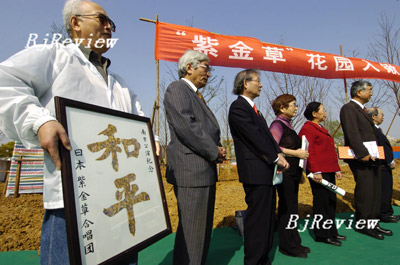
"If Japanese Prime Minister Shinzo Abe's visit to China last October was an ice-breaking journey, I hope that my visit to Japan in April will be an ice-melting one," Chinese Premier Wen Jiabao said at a press conference on March 16 concluding the annual session of the National People's Congress.
In the meantime, during their visit to Beijing, Hidenao Nakagawa, Secretary- General of the Liberal Democratic Party (LDP), and Kazuo Kitagawa, Secretary- General of the New Komeito party, (both parties are in the ruling coalition), said the two sides should remove the "drifting ice" and adopt a win-win strategy in resolving the problems in their bilateral ties.
The phrases "ice-breaking," "ice-melting" and "removing the drifting ice" accurately describe the fact that Sino-Japanese ties have moved out of a five-year-long impasse and onto the path of continuous normalization and stabilization of the two countries' relationship.
Chinese President Hu Jintao has stressed that it is important to treat the bilateral ties and deepen the friendship between the two countries from a strategic perspective. During Abe's visit in October 2006, the leaders decided to develop "strategic, mutually beneficial ties." In late January, Japan "upgraded" its "comprehensive policy dialogue" to a "strategic dialogue," signaling a consensus on approaching bilateral ties from a strategic perspective.
The key connotation of the word "strategic" is the relationship between the "parts" and the "whole." When addressing disputes-that is, "removing drifting ice"-one should not only see the leaves but also the forest. Although each tree in the forest is important, one cannot maintain a tree at the cost of the entire forest.
As the late Chinese leader Deng Xiaoping pointed out, maintaining friendly cooperation between the two countries is a mission not only endowed by history, but also by reality. Whoever the Chinese or Japanese leader is, he must not violate this precondition. From a strategic point of view, any differences or difficulties in bilateral ties are temporary, insubstantial and not insurmountable. The friendship between China and Japan is the overarching theme that outweighs any "differences or difficulties."
From a strategic point of view, the friendship between China and Japan is the trunk of a tree, whereas frictions and conflicts between the two countries are some leaves. The late Chinese Premier Zhou Enlai once said that we should "seek common ground on major questions while reserving differences on minor ones." We should not endanger our friendship just because of some differences. This serves as a good guideline for Sino-Japanese relations and for the handling of such issues as the war legacy and the disputes over the East China Sea. Since 2001, former Japanese Prime Minister Junichiro Koizumi's frequent visits to the Yasukuni Shrine damaged bilateral ties. We must learn a lesson from this and avoid such an impasse in the future.
Wen's trip is the first one that a Chinese premier has paid to Japan in the past seven years. We are confident that this historic visit will be successful, and the expectations of the two leaders and two peoples to strengthen bilateral ties will melt the hard and drifting ice between them. After a farewell to the cold winter of bilateral ties, we are ready to embrace the warm spring.
Sino-Japanese relations are the ties between the two peoples. Wen remarked, "Developing friendship is the common aspiration of the two peoples, which cannot be blocked by anyone." The bilateral relations are not to fulfill the global ambition of any big power, or to win votes for any political party, but to benefit the peoples in the two countries, as well as the people in Asia and the world.
Who is developing Sino-Japanese relations? It is the two peoples. Centuries of friendship between the two brought about the normalization of bilateral ties in 1972, a milestone in the historically friendly relations between the two nations.
The trade volume between China and Japan surpassed $200 billion in 2006. China is expected to replace the United States as the leading trade partner of Japan in 2007. If the Hong Kong Special Administrative Region (SAR) is included, trade between China and Japan has already surpassed that between China and the United States. As Kitagawa of the New Komeito party said, "The economies of China and Japan are interdependent and inseparable," and hence the economic ties should be a win-win game rather than a zero sum game. China's growth into an economic power is in the interests of Japan. Japan has emerged from "a lost decade," which is in the interests of China. Economic interactions between the two countries will further enhance mutual understanding.
| 